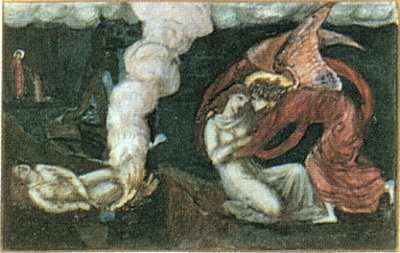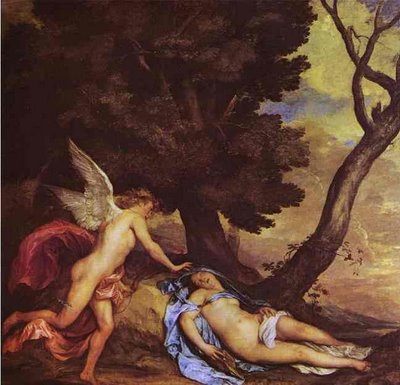Chapter 9: Cupid Returns
The mist that puts Psyche into a sleep or coma shows her defeat by the element of air, which spreads poisons, in this case probably the sulphur which was just too concentrated to stay in solid form once it got to the surface. Out of its container, it turns into a gas (9a, watercolor by Burne-Jones, 1860’s) that is poisonous to Psyche, or at least to her conscious ego.

Cupid, now healed of his wound, gets up out of his sick bed and flies to Psyche’s side. As Sulphur personified, it is easy for him to put the gas back in the box. The Burne-Jones watercolor puts Christian myth into the tale, adding the halos. Making her white, the gas white, and him red is a touch the alchemists would love. White is the lunar stage, feminine, and the alchemists praise the “white fume” without which there would not be arise the “white gold of alchemy” (Fabricius 130). Red is the masculine color, both the raw, impulsive masculine and the final stage, the red of the sunrise and the risen Christ. In Burne-Jones's painting, the two form a circle or mandala.
Alchemically Cupid’s return corresponds to "The Soul's Jubilation," the Iubilatio, Emblem 10 of the Rosarium (9b).

The soul rejoices at the body’s resurrection-—or, taking the masculine image as spirit, the spirit rejoices at the resurrection of soul. As I see it, the two birds mirror the pair above; the bird that is free will extricate, beak to beak, the bird that is partially buried. Thus the spirit, the twin of the soul, will transform the soul so as later to free it from the body and elevate it to its own realm. that will set her free. The text accompanying the emblem sets the tone: “Our sublimation is nothing but the exaltation of the body, that is, its transformation into spirit” (Fabricius 124). Exposed to immortal beauty, it becomes a spiritual body. The transformation has been prepared for by the soul’s purification, the removal of the “dregs” of materiality, i.e. childish behavior. She is now an initiate into the mysteries of Venus.
In von Gierke’s version the box is turned over, her body askew (9c); the painting is entitled “Psyche/Amor.” Cupid seems to survey the scene from a distance before he comes in, as though watching from above as he did in the beginning.

Cupid does come to Psyche’s side (9d, fresco by Gulio Ramono), with Cerberus licking his chops).

The 4 tasks have been his as well, and have strengthened him. The purification is a process for both Sulphur and Mercury, i.e. Cupid and Psyche. In Gnostic myth it is Christ coming back to Sophia, saving the human soul. In her coma she has experienced death before death. She is now ready for her resurrection.
Is Psyche really in a coma, near death, or merely asleep, like the princess in the fairy tales waiting for some prince to wake her up? The artists tend to opt for the coma, which is certainly more dramatic. Besides the version we just saw, another example is by the Baroque Flemish painter Anthony van Dyck, who puts a tree next to Psyche with two trunks, one dead and one living (9e, 1634).

Psyche is between life and death. This interpretation also fits where Psyche is, only barely out of Hades. But both options work. If Cupid does not act, she may die. Or, if he does not act, some other guy will wake her up instead. But the coma is more life-changing. It may be seen in terms of near-death experiences (here I thank a discussant at the Gnostic Church presentation). You want to go to the other side, but a voice or presence says, not yet, and then you must choose. When you come back, your life is fundamentally different than it was before; you are transformed.
Von Gierke, perhaps strangely, has as his next painting not a version of Cupid by Psyche’s side, but rather another one, entitled “Psyche/Venus,” in which the prone figure is supplemented by a painting of its mirror image (9f).

But again, it is not a true mirror, because the floor is not a mirror image. The box is now upright. Has Cupid been and gone? Are Venus and Psyche now mirror images, both unconscious, the immortal one being in the picture and the mortal one on the floor?
As in most fairy tales, the kiss is what revives (9g, “Cupid Awakening Spyche with a Kiss” by Antonio Canova, 1793). It is the beginning of the second coniunctio; which will culminate in Psyche’s ascent.

In place of the kiss, what von Gierke sees is the painter in the painting, or in the glass that reflects his image in front of the painting (9h; the title is “spiegelung/mann”, or “reflection/man”). His head merges with hers, while facing away from the woman’s head. Unrelated yet also related, perhaps.

So Psyche brings Venus the beauty from Hades in triumph (9i, Raphael).

Apuleius does not record Venus’s reply. Perhaps she is speechless, or realizes that the affair is now out of her hands.
Meanwhile Cupid does not rest on his laurels. Finally in action, he appeals to Jupiter to legitimize his union with Psyche (9j, Raphael). Jupiter makes him a deal: Psyche will be made immortal and Cupid’s wife if Cupid will not undermine Jupiter’s edict against adultery, except to assist Jupiter himself, of course..

At the bidding of Jupiter, Mercury then bears Psyche to Olympus (9k, Raphael):

Artists also represent Psyche as being borne upwards by Cupid, as in the 1890’s painting by Adolph Bouguereau (9l).

From a Christian perspective, one might imagine these ascents as Christ's lifting up of Sophia in Gnostic myth, or more traditionally his bearing up of either of the Marys, the Virgin or the Magdalene--or, more generally, Christ's bearing up the soul of the faithful.
The scene also resembles the albedo in alchemy, the uplifting of the body, formerly black but now white, transformed into spirit. It is Emblem 10 of the Rosarium (9k), with suitable remnants of Psyche's trials-—the Mercury on the tree, the three-headed snake, and the bird.

The actual term “albedo” is not used in the Rosarium text. However the words make this meaning clear enough: “The quicksilver which is extracted from that black body is humid and white and pure with bark so that it will not perish” (Fabricius 130).
Now Psyche may drink Jupiter’s ambrosia of immortality (9m, by the Danish artist Herman Vilhelm Bissen, 1807).

With Psyche officially an immortal, the pair may may celebrate their wedding (9n, by Gulio Romano). We are looking up to the midpoint of the ceiling, with Jupiter and Juno at the top, and Cupid and Psyche reaching for each other’s hands in the middle.

In Apuleius’s Platonist reading, soul and spirit achieve a lasting union through immortality, the mortal of the pair becoming mortal. Wim Wenders, of course, sees it differently. For him, Cupid can only have Psyche if he becomes mortal. So Bruno Ganz sheds his wings and walks on two feet. In so doing, however, the world that formerly appeared in shades of gray now light up in living color. Even the Berlin Wall is no longer gray (9o).


Cupid, now healed of his wound, gets up out of his sick bed and flies to Psyche’s side. As Sulphur personified, it is easy for him to put the gas back in the box. The Burne-Jones watercolor puts Christian myth into the tale, adding the halos. Making her white, the gas white, and him red is a touch the alchemists would love. White is the lunar stage, feminine, and the alchemists praise the “white fume” without which there would not be arise the “white gold of alchemy” (Fabricius 130). Red is the masculine color, both the raw, impulsive masculine and the final stage, the red of the sunrise and the risen Christ. In Burne-Jones's painting, the two form a circle or mandala.
Alchemically Cupid’s return corresponds to "The Soul's Jubilation," the Iubilatio, Emblem 10 of the Rosarium (9b).

The soul rejoices at the body’s resurrection-—or, taking the masculine image as spirit, the spirit rejoices at the resurrection of soul. As I see it, the two birds mirror the pair above; the bird that is free will extricate, beak to beak, the bird that is partially buried. Thus the spirit, the twin of the soul, will transform the soul so as later to free it from the body and elevate it to its own realm. that will set her free. The text accompanying the emblem sets the tone: “Our sublimation is nothing but the exaltation of the body, that is, its transformation into spirit” (Fabricius 124). Exposed to immortal beauty, it becomes a spiritual body. The transformation has been prepared for by the soul’s purification, the removal of the “dregs” of materiality, i.e. childish behavior. She is now an initiate into the mysteries of Venus.
In von Gierke’s version the box is turned over, her body askew (9c); the painting is entitled “Psyche/Amor.” Cupid seems to survey the scene from a distance before he comes in, as though watching from above as he did in the beginning.

Cupid does come to Psyche’s side (9d, fresco by Gulio Ramono), with Cerberus licking his chops).

The 4 tasks have been his as well, and have strengthened him. The purification is a process for both Sulphur and Mercury, i.e. Cupid and Psyche. In Gnostic myth it is Christ coming back to Sophia, saving the human soul. In her coma she has experienced death before death. She is now ready for her resurrection.
Is Psyche really in a coma, near death, or merely asleep, like the princess in the fairy tales waiting for some prince to wake her up? The artists tend to opt for the coma, which is certainly more dramatic. Besides the version we just saw, another example is by the Baroque Flemish painter Anthony van Dyck, who puts a tree next to Psyche with two trunks, one dead and one living (9e, 1634).

Psyche is between life and death. This interpretation also fits where Psyche is, only barely out of Hades. But both options work. If Cupid does not act, she may die. Or, if he does not act, some other guy will wake her up instead. But the coma is more life-changing. It may be seen in terms of near-death experiences (here I thank a discussant at the Gnostic Church presentation). You want to go to the other side, but a voice or presence says, not yet, and then you must choose. When you come back, your life is fundamentally different than it was before; you are transformed.
Von Gierke, perhaps strangely, has as his next painting not a version of Cupid by Psyche’s side, but rather another one, entitled “Psyche/Venus,” in which the prone figure is supplemented by a painting of its mirror image (9f).

But again, it is not a true mirror, because the floor is not a mirror image. The box is now upright. Has Cupid been and gone? Are Venus and Psyche now mirror images, both unconscious, the immortal one being in the picture and the mortal one on the floor?
As in most fairy tales, the kiss is what revives (9g, “Cupid Awakening Spyche with a Kiss” by Antonio Canova, 1793). It is the beginning of the second coniunctio; which will culminate in Psyche’s ascent.

In place of the kiss, what von Gierke sees is the painter in the painting, or in the glass that reflects his image in front of the painting (9h; the title is “spiegelung/mann”, or “reflection/man”). His head merges with hers, while facing away from the woman’s head. Unrelated yet also related, perhaps.

So Psyche brings Venus the beauty from Hades in triumph (9i, Raphael).

Apuleius does not record Venus’s reply. Perhaps she is speechless, or realizes that the affair is now out of her hands.
Meanwhile Cupid does not rest on his laurels. Finally in action, he appeals to Jupiter to legitimize his union with Psyche (9j, Raphael). Jupiter makes him a deal: Psyche will be made immortal and Cupid’s wife if Cupid will not undermine Jupiter’s edict against adultery, except to assist Jupiter himself, of course..

At the bidding of Jupiter, Mercury then bears Psyche to Olympus (9k, Raphael):

Artists also represent Psyche as being borne upwards by Cupid, as in the 1890’s painting by Adolph Bouguereau (9l).

From a Christian perspective, one might imagine these ascents as Christ's lifting up of Sophia in Gnostic myth, or more traditionally his bearing up of either of the Marys, the Virgin or the Magdalene--or, more generally, Christ's bearing up the soul of the faithful.
The scene also resembles the albedo in alchemy, the uplifting of the body, formerly black but now white, transformed into spirit. It is Emblem 10 of the Rosarium (9k), with suitable remnants of Psyche's trials-—the Mercury on the tree, the three-headed snake, and the bird.

The actual term “albedo” is not used in the Rosarium text. However the words make this meaning clear enough: “The quicksilver which is extracted from that black body is humid and white and pure with bark so that it will not perish” (Fabricius 130).
Now Psyche may drink Jupiter’s ambrosia of immortality (9m, by the Danish artist Herman Vilhelm Bissen, 1807).

With Psyche officially an immortal, the pair may may celebrate their wedding (9n, by Gulio Romano). We are looking up to the midpoint of the ceiling, with Jupiter and Juno at the top, and Cupid and Psyche reaching for each other’s hands in the middle.

In Apuleius’s Platonist reading, soul and spirit achieve a lasting union through immortality, the mortal of the pair becoming mortal. Wim Wenders, of course, sees it differently. For him, Cupid can only have Psyche if he becomes mortal. So Bruno Ganz sheds his wings and walks on two feet. In so doing, however, the world that formerly appeared in shades of gray now light up in living color. Even the Berlin Wall is no longer gray (9o).


0 Comments:
Post a Comment
<< Home